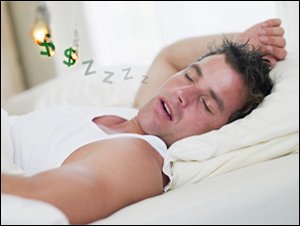 Recent studies conducted by the The National Institutes of Health estimates that 1 in 10 adults over the age of 65, or about 18 million Americans, suffer from obstructive sleep apnea (OSA). Those who have OSA experience plenty of trouble while sleeping, most notably breathing that is interrupted due to obstruction caused by a soft palate collapse which includes the tongue, uvula, adenoids, and other soft tissues within the throat.
Recent studies conducted by the The National Institutes of Health estimates that 1 in 10 adults over the age of 65, or about 18 million Americans, suffer from obstructive sleep apnea (OSA). Those who have OSA experience plenty of trouble while sleeping, most notably breathing that is interrupted due to obstruction caused by a soft palate collapse which includes the tongue, uvula, adenoids, and other soft tissues within the throat.
Patients with OSA can have obstructed breathing for upwards of a minute, and this phenomena occurs hundreds of times at night. Since normal breathing is interrupted, the body is starved of needed oxygen, which can lead to future health problems such as stroke, diabetes, and cardiovascular disease. On a daily basis, most patients with OSA suffer from daytime sleepiness, fatigue, and a lack of energy.
In the dental and health world, OSA is often treated with the CPAP machine, though this treatment option doesn’t always work for everyone. “Some patients are CPAP-intolerant and do not experience the needed treatment that is required to ensure a constant breathing pattern throughout the night,” explained Dr. Kevin Berry, a Denver sleep dentist. For those patients who are CPAP-intolerant, other treatment methods do exist, such as oral appliance therapy.
Another type of treatment method that is currently being researched is an implantable device that can be used for those with moderate to severe OSA. Known as Inspire Upper Airway Stimulation (UAS) therapy, the device is implanted as a way to help prevent any type of airway obstruction that can occur while the patient sleeps. The UAS is implanted near the clavicle and is then connected to a stimulation lead that is located near the airway. The lead is designed to provide for a mild and timed stimulation of the hypoglossal nerve. When the hypoglossal nerve is stimulated, the UAS is able to bring back tone to the muscles that control the tongue’s base. This prevents a soft palate collapse that often leads to obstruction.
As explained by Dr. Don Lowrance, a general dentist in San Antonio who offers sleep apnea treatment as his primary service, “The theory behind the UAS is that when the tongue is regularly and properly stimulated, a normal breathing pattern can be created and maintained throughout the night, which means an end to the interrupted sleep patterns that usually occur in OSA patients.”
This technology has been in the works for some time, and many sleep apnea treatment providers are skeptical of its practicality. Surgery is always something that patients and doctors alike would prefer to avoid, but for patients who have tried CPAP and oral appliance therapy, surgery is frequently the last resort. The UAS would provide yet another “weapon” in the arsenal for health care providers who treat sleep apnea.
The UAS surgery will easily be more expensive than CPAP and certainly much more costly than an oral appliance created by a sleep dentist that generally runs $1,500-$3,000 and requires little in the way of follow-up care. Despite the lower cost and having been in use for several decades, oral appliances have only recently seen medical insurance coverage for patients from the larger insurance companies. Insurance coverage for the UAS procedure will likely be slow in coming if it is ever covered at all.
About the author: Ashley Page is a writer for Off-Topic Media. Dr. Kevin Berry provides TMJ and sleep apnea treatment in Denver, Colorado. Dr. Don Lowrance practices in San Antonio and Corpus Christi, Texas.